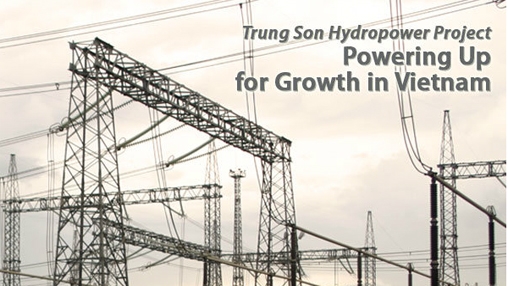Overview
Trung Son is a US$411.57 million medium-sized hydropower and development project located in Northwest Vietnam that will supply affordable, clean, and sustainable electricity for domestic consumption. The project will also contribute to the climate change agenda in Vietnam by avoiding CO2 emissions of about 1 million tons per year (net) taking into account the additional low emissions from its reservoir.
Trung Son will enable Vietnam’s energy security by developing an additional 260MW of electricity-generating capacity to meet expansion requirements in the sector. It also meets the rising energy demands of a country whose economy has been growing at more than 7% annually over the past several years.
Trung Son Hydropower Project (TSHPP) was approved by the World Bank Board of Executive Directors on April 26th, 2011, and is the first World Bank investment project under IBRD lending conditions to the Government of Vietnam.
Challenges
Vietnam’s annual growth rate of 7-8% during the period of 1996-2010 has led to an increasing demand for power. Electricity consumption in Vietnam has been growing at 15% annually for the past several years. Chronic shortages are affecting the agricultural, industrial and services sector, while many houses still have no electricity. To meet this demand—estimated at an installed capacity of 39GW by 2020, compared to 15.8 GW in 2008—the Government is developing a range of power sources, including hydropower.
Approach
Trung Son Hydropower Project’s implementation is being undertaken by the Trung Son Hydropower Company (TSHPCo), a unit under Vietnam Electricity (EVN), and the national electricity utility. It is responsible for ensuring the entire project is implemented according to both Government and World Bank requirements. EVN created the Trung Son Hydropower Company (TSHPCo) as a One-member Company from the former TSHPMB. TSHPCo is a wholly owned subsidiary of EVN into which all the assets of Trung Son Hydropower Plant (TSHPP) will be placed. The Trung Son Hydropower Company has a dedicated website (http: //www.trungsonhp.vn) where publicly available information is updated and placed.
Trung Son Hydropower Project includes the development, construction, and operation of the power plant using water from the Ma River and releasing it into the same basin. The project site is located 48km from the border with Lao PDR in Son La, Than Hoa and Hoa Bin provinces in northwestern Vietnam, with the plant in the territory of Trung Son commune, Quan Hoa district, Thanh Hoa province
The Trung Son project has a robust, multi-layer monitoring and evaluation framework consisting of the following elements:
• Project Technical Advisory Panel (PTAP)
• Panel of Environmental and Social Experts (POE),
• Independent monitoring consultants (IMC),
• Regular supervision by staff of the World Bank,
Benefits
The project aims to provide safe, affordable and sustainable power supply which will also provide the following benefits:
• Improvement in living conditions for over 2,000 people that will be relocated;
• Livelihood restoration activities for over 7,000 people whose household are affected by the project;
• US$2 million for specific environmental programs that go further than the EMP, including US$700,000 for the protection of 3 natural biodiversity preserves in the Project areas;
• Continuous consultations with villagers on their preferences related to the social change;
• Employment opportunities for Vietnamese workers during construction years;
• Improved road access for villagers and surrounding areas, including 25 km access road connecting the Project site;
• Increase Vietnam’s power supply with an additional 1019GW a year; while CO2 emissions of about 1 million tons per year will be avoided;
• Provide flood control benefits through a water storage capacity of 112 million m3.
World Bank Contribution
The World Bank is providing financial support in the form of a loan of US$330 million payable with a 27 year maturity and a grace period of 6 years. The loan includes support for equipment, civil works and technical assistance
Toward the Future
The Trung Son Hydropower project is a good example of a well-designed, medium-scale hydropower project that meets international good practices in technical design, analysis of alternatives, and particularly environmental, social and dam safety elements. Given Vietnam’s plans to develop a series of medium scale hydropower projects in the coming years, the first hydropower project that the World Bank is financing in Vietnam can serve as a good practice example upon which subsequent projects can build. The Trung Son Hydropower Project is an example of how hydropower can help support Vietnam’s development in an economically, environmentally and socially sustainable way.
For more information
Please visit www.worldbank.org/vn/trungson or contact any of the people listed below:
In Hanoi
The Trung Son Hydropower Project Team: trungsoninquiries@worldbank.org
Mr. Franz Gerner (Trung Son team leader): fgerner@worldbank.org
Ms. Mai Thi Hong Bo: mbo@worldbank.org
In Washington, DC
Mr. Carl Hanlon: chanlon@worldbank.org
More detailed aspects of the project in all sections and components described above can be found in the Project Appraisal Document, publicly available after the IBRD/DA World Bank Board of Executive Directors' approval.


